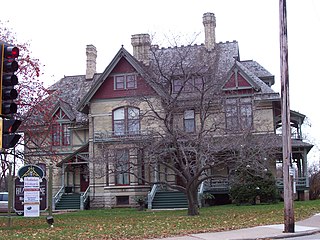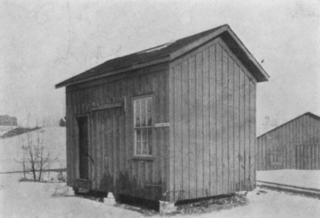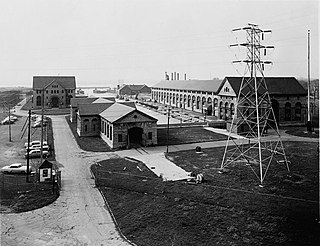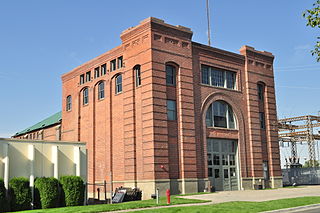
Saint Anthony Falls, or the Falls of Saint Anthony located at the northeastern edge of downtown Minneapolis, Minnesota, is the only natural major waterfall on the Mississippi River. Throughout the mid-to-late 1800’s, various dams were built atop the east and west faces of the falls to support the milling industry that spurred the growth of the city of Minneapolis. In 1880, the central face of the falls was reinforced with a sloping timber apron to stop the upstream erosion of the falls. In the 1950s, the apron was rebuilt with concrete, which makes up the most visible portion of the falls today. A series of locks were constructed in the 1950s and 1960s to extend navigation to points upstream.

The Hearthstone Historic House Museum is a historic home in Appleton, Wisconsin, United States that has been converted into a museum. On September 30, 1882, it became the first residence in the US powered by a centrally located hydroelectric station using the Edison system. At that time, the house was the residence of Henry James Rogers, a paper company executive and entrepreneur. It was listed on the National Register of Historic Places on December 2, 1974. The house was previously known as the Henry J. Rogers House.

The Holyoke Canal System is a system of power canals in Holyoke, Massachusetts. It is split into three canals based on elevation and distance from the inlet at the Holyoke Dam- the First Level Canal, Second Level Canal, and Third Level Canal. Constructed over a period between 1847 and 1892, the Canal System, along with the Dam, is recognized as a Historic Mechanical Engineering Landmark by the American Society of Mechanical Engineers for its use in the development of the Venturi meter by Clemens Herschel, the first means of measuring large-scale flows, and the McCormick-Holyoke Turbine by John B. McCormick, which doubled the efficiency of turbines to more than 80% in its time.

The Vulcan Street Plant was the first Edison hydroelectric central station. The plant was built on the Fox River in Appleton, Wisconsin, and put into operation on September 30, 1882. According to the American Society of Mechanical Engineers, the Vulcan Street plant is considered to be "the first hydro-electric central station to serve a system of private and commercial customers in North America". It is a National Historic Mechanical Engineering Landmark, an IEEE milestone and a National Historic Civil Engineering Landmark.

Falls Park is a public park in north central Sioux Falls, South Dakota, surrounding the city's waterfalls. The park includes a cafe, an observation tower, and the remains of an old mill.

Croton Dam is an earth-filled embankment dam and powerplant complex on the Muskegon River in Croton Township, Newaygo County, Michigan. It was built in 1907 under the direction of William D. Fargo by the Grand Rapids - Muskegon Power Company, a predecessor of Consumers Energy. The 40-foot-high (12 m) dam impounds 7.2 billion U.S. gallons (6 billion imp. gal/27 billion L) of water in its 1,209-acre (489 ha) reservoir and is capable of producing 8,850 kilowatts at peak outflow. It was listed on the National Register of Historic Places in 1979.

Adams Power Plant Transformer House in Niagara Falls, New York is a National Historic Landmarked building constructed in 1895. It is the only remaining structure that was part of the historic Edward Dean Adams Power Plant, the first large-scale, alternating current electric generating plant in the world, built in 1895. The building's eponym was Edward Dean Adams, a businessman and entrepreneur in the electrical field.

Bridal Veil Falls is a 365-foot waterfall at the end of the box canyon overlooking Telluride, Colorado. Hiking and off-road trails pass by the falls and it has a hydroelectric power plant at its top. In winter the frozen shape of the falls forms an imposing challenge to intrepid ice climbers.

The Sioux Quartzite is a Proterozoic quartzite that is found in the region around the intersection of Minnesota, South Dakota, and Iowa, and correlates with other rock units throughout the upper midwestern and southwestern United States. It was formed by braided river deposits, and its correlative units are thought to possibly define a large sedimentary wedge that once covered the passive margin on the then-southern side of the North American craton. In human history, it provided the catlinite, or pipestone, that was used by the Plains Indians to carve ceremonial pipes. With the arrival of Europeans, it was heavily quarried for building stone, and was used in many prominent structures in Sioux Falls, South Dakota and shipped to construction sites around the Midwest. Sioux Quartzite has been and continues to be quarried in Jasper, Minnesota at the Jasper Stone Company and Quarry, which itself was posted to the National Register of Historic Places on January 5, 1978. Jasper, Minnesota contains many turn-of-the-century quartzite buildings, including the school, churches and several other public and private structures, mostly abandoned.

The Toronto Power Generating Station is a former generating station located along the Niagara River in Niagara Falls, Ontario, Canada, slightly upstream from the newer Rankine power station. Completed in 1906 in the Beaux-Arts-style, the station was designed by architect E. J. Lennox and was built by the Electrical Development Company of Ontario (owned by William Mackenzie, Frederic Thomas Nicholls, and Henry Mill Pellatt) under supervision of Hugh L. Cooper to supply hydro-electric power to nearby Toronto, Ontario.

The history of electricity sector in Canada has played a significant role in the economic and political life of the country since wide-scale industrial and commercial power services spread across the country in the 1880s. The development of hydropower in the early 20th century has profoundly affected the economy and the political life in Canada and has come to symbolize the transition from "old " industrialism of the 19th century to a "new", modern and diversified, Canadian economy.

The Lanark Hydro Electric Scheme refers to two hydroelectric plants in the Clydesdale area of South Lanarkshire, Scotland. They take in water from the Falls of Clyde.

The Schoellkopf Power Station was built on land owned by Jacob F. Schoellkopf above the Niagara Gorge near the American Falls, 1,600 feet (490 m) downriver from Rainbow Bridge. Understanding the growing need for electricity and the role of harnessing the Falls, Schoellkopf purchased the land for the hydraulic canal on May 1, 1877 for $71,000. After Schoellkopf Sr.'s death in 1903, his sons took over the operation of the power business. In 1918, Schoellkopf's Niagara Falls Hydraulic Power and Manufacturing Company merged with the Niagara Falls Power Company, which was owned by Edward Dean Adams. Much of the site is, as of 2014, occupied by the Maid of the Mist tour boat company as a maintenance area and off-season boat storage yard. The power station remains form a part of a fully accessible tourist attraction associated with Niagara Falls State Park and is connected with its Niagara Gorge hiking trail system.

The Carnegie Free Public Library, also known as the Carnegie Town Hall, is a historic Carnegie library located at 235 W. 10th St. in Sioux Falls, South Dakota. The library was built in 1903 through a $25,000 grant from the Carnegie Foundation. Architect Joseph Schwartz designed the building, a Romanesque Revival structure with Neoclassical influences. The library was built from locally quarried quartzite, a popular local building material at the turn of the century. While the building's massive form and rough-hewn stone exterior are Romanesque, it features a Greek pediment above the entrance supported by four pilasters on either side of the doorway. The building represents the only use of Classical details in a quartzite building in Sioux Falls.

The Queen Bee Mill is a ruined mill complex located in Falls Park in Sioux Falls, South Dakota. The mill was built between 1879 and 1881 under the guidance of politician Richard F. Pettigrew, who believed that Sioux Falls could harness the power of the Big Sioux River for local industry. When it opened in 1881, the mill could process 1200 barrels of grain per day, and its elevator could hold 130,000 bushels; it also had connections to all five of the city's rail lines. Business at the mill could never meet its capacity, however, and it closed only two years after it opened due to bankruptcy. The mill passed through several owners after it closed; while several attempted to reopen it, none succeeded, and the building eventually became a warehouse. A fire destroyed the complex in 1956; the foundations of the mill and grain elevator are all that remain at the site.
The Bodwell Water Power Company Plant, also known as the Milford Plant of Emera Maine, is a hydroelectric power generation facility on the Penobscot River in Milford, Maine. Its main building, a handsome Romanesque structure, stands at the eastern end of the Milford Dam. Built in 1906, it was at that time the largest hydroelectric facility in the state, and its construction marked a shift from water to electrical power of area industries. It was listed on the National Register of Historic Places in 1988.

Linton Falls Hydro is a hydroelectric generating power station located on the Linton Falls Weir of the River Wharfe, near Grassington, North Yorkshire, England. The power station is located on the same site as a hydroelectric scheme that was first opened in 1909, but had closed by 1948. The new scheme, which opened in March 2012, uses the original building which is now a scheduled monument.
St. Anthony Falls in Minneapolis, Minnesota, is the only natural falls on the Mississippi River. Since almost the beginning of settlement in the area by European descendants, the St. Anthony Falls have been used for waterpower. The first allowed settlers were at Ft. Snelling, where construction began in 1820. A sawmill was operating 1821 and a flour mill in 1823. As soon as the land at the sides of the falls became available it was purchased with the intent of using the waterpower of the falls. First lumber mills covered the falls, cutting lumber floated down the Mississippi. After 1870 flour mills started to dominate the area. From 1880 to 1930 the area was the number one flour producer in the US. In later years, some of the power came from steam, but in 1923 half of the waterpower used was for flour milling. Other industries have also used the waterpower.

The Electric Light Works Building, also known as Gesa Power House Theatre, is a noteworthy building in Walla Walla, Washington that has aided in the growth and success of the city. It started out as a substation in the early 20th century, supplying Walla Walla with electricity. It was one of the first substations that converted hydropower to electricity in Washington state and is a good example of industrial architecture in the 1900s. Today it is as much a symbol of Walla Walla’s history as it is of the ever-changing culture of Walla Walla.

Seattle Municipal Light and Power Plant, also known as Cedar Falls Historic District, is a public hydroelectric plant near North Bend, Washington operated by Seattle City Light. The plant was the first publicly-owned electrical generating plant for Seattle and one of the earliest in the country for a municipality of its size. It was listed on the National Register of Historic Places in 1997.























